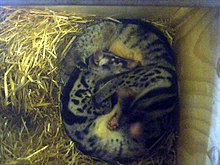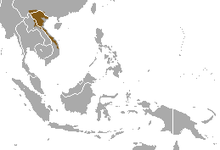Owston's palm civet
| Owston's palm civet | |
|---|---|
 | |
| Owston's palm civets in captivity | |
| Scientific classification | |
| Domain: | Eukaryota |
| Kingdom: | Animalia |
| Phylum: | Chordata |
| Class: | Mammalia |
| Order: | Carnivora |
| Suborder: | Feliformia |
| Family: | Viverridae |
| Subfamily: | Hemigalinae |
| Genus: | Chrotogale Thomas, 1912 |
| Species: | C. owstoni |
| Binomial name | |
| Chrotogale owstoni (Thomas, 1912) | |
 | |
| Owston's palm civet range | |
Owston's palm civet (Chrotogale owstoni) is a viverrid native to Vietnam, Laos and a very small portion of southern China, in three counties located in the Yunnan province: Hekou, Luchun, and Jinping, and has never been found west of the Mekong River. It is listed as Endangered on the IUCN Red List because of an ongoing population decline, estimated to be more than 50% over the last three generations, inferred from over-exploitation, habitat destruction and degradation.
Taxonomy[edit]
The Owston's palm civet was described by Oldfield Thomas in 1912 on the basis of a skull and skin of zoological specimen collected by Alan Owston by a river in Tonkin.[2] Chrotogale is a monospecific genus.[3]
Characteristics[edit]
The Owston's palm civet has a tawny buff-grey body with highly contrasted black markings on its back and tail, and four bands on its back.[4] These bands run from around the eyes to the first third of the tail.[5] It has large rounded ears and black eyes. is a mid-sized palm civet at 57 cm (22 in) plus a tail of 43 cm (17 in), weighing around 1.8–2.7 kg (4–6 lb).[6] The last two-thirds of the tail is completely black, and there are black spots on the legs. Both males and females of this species are very skinny.[6] Since both males and females have the same markings, the only way to distinguish the sexes is through looking at genitalia and pelage. Females have an orange pelage only on their lower bellies, whereas males have an orange patch through the chest, that differs in hue from the ones of females.[5]
Distribution and habitat[edit]
Owston's palm civet lives in lowland evergreen forests where dry seasons are not too harsh. They live in a restricted range of territory, spanning Vietnam, Laos and a very small portion of southern China, as well as the Annamite mountains.[7] Based on camera trapping studies, it is likely that its range is limited to only certain forests within these regions, the moist tropical evergreen forests, subtropical forests, and limestone forests.[5]
Behavior and ecology[edit]
Very little is known about the life history of the Owston's palm civet in the wild, though limited information has been gathered on captive animals. It is a solitary species, except during mating season. It is nocturnal, being active only during complete darkness in the wild, but being active from sundown to dawn in captivity.[6] It is mainly terrestrial, spending most of their time foraging on the forest floor, but on occasion, they may climb trees and shrubbery in order to sleep.[5] It marks objects with both urine and scent glands located on their underbellies. This marking occurs most often during breeding season, but the exact reason for marking is unknown.[6]
Diet[edit]
The Owston’s Civet spends most of its time foraging on the ground for fruits and soft-bodied animals, with a particular fondness for insects and earthworms. Based on its dentition observed in captivity, it is not able to eat large or bony animals.[5]
Reproduction[edit]
There is no known information about the reproductive habits of this palm civet in the wild. Based on when traders see pregnant females, it is assumed that the mating season is between January and May.[4] In captivity, females give birth to litters of 1-3 cubs after a gestation of 75 to 90 days. Pups are born with their eyes closed and weigh 80–135 g (2.8–4.8 oz). After about 10 days, they begin to walk, and reach independence at 12 to 18 weeks as they are weaned off their mother. At the age of 18 to 24 months, they are sexually mature and able to reproduce next mating season.[6]
Threats[edit]
The Owston's palm civet is listed as Endangered on the IUCN Red List, because the population is thought to have declined due to over-exploitation and habitat fragmentation.[1] The largest threat is hunting, specifically non-specific mammal hunting. While Owston's palm civet is not a particular target for hunters, it still suffers casualties mostly due to snares placed by hunters.[8] Most of the hunting in the region occurs within protected areas, where it is illegal to set any type of trap.[9] The urban demand for wild meat lead to an increase of hunting in both protected areas and outside of protected areas. In some areas of Vietnam and Laos, there are hundreds of snares per kilometer.[10]
Conservation[edit]
Conservationists developed a 10-year plan in order to help preserve the Owston’s palm civet. The conservation priorities are to cut down on snaring and to reduce the consumption of wild meat. They propose to do this by bringing the wild meat issue to the government, in hopes of passing laws to change the behavior. They also hope to establish a genetically diverse Owston’s palm civet population that can be released back into the wild.[8]
In captivity[edit]
The Carnivore and Pangolin Conservation Program in Cúc Phương National Park was founded in 1995 and is the only center for rehabilitation and breeding of the Owston's palm civet; the program is run in cooperation with various zoos including Newquay Zoo.[4] Since it was founded in 1995, 14 Owston's palm civets were rescued and rehabilitated, and 66 were born in the center as of the 2019 conservation planning workshop for the Owston's palm civet.[4] The Newquay Zoo keeps two Owston's civets brought from Vietnam in 2005.[11]
References[edit]
- ^ a b Timmins, R.J.; Coudrat, C.N.Z.; Duckworth, J.W.; Gray, T.N.E.; Robichaud, W.; Willcox, D.H.A.; Long, B.; Roberton, S. (2016). "Chrotogale owstoni". IUCN Red List of Threatened Species. 2016: e.T4806A45196929. doi:10.2305/IUCN.UK.2016-1.RLTS.T4806A45196929.en. Retrieved 19 November 2021.
- ^ Thomas, O. (1912). "Two new genera and a species of Viverrine Carnivora". Proceedings of the Zoological Society of London. Part II: 498–503.
- ^ Wozencraft, W. C. (2005). "Genus Chrotogale". In Wilson, D. E.; Reeder, D. M. (eds.). Mammal Species of the World: A Taxonomic and Geographic Reference (3rd ed.). Johns Hopkins University Press. p. 552. ISBN 978-0-8018-8221-0. OCLC 62265494.
- ^ a b c d "Owston's Civet". Save Vietnam's Wildlife. 2019. Retrieved 2024-02-29.
- ^ a b c d e Robertson. S; Heard-Rosenthal, S; Muir. S. (2002). Management Guidelines for Owston's palm civet, Chrotogale owstoni (Thomas 1912) (PDF). Cuc Phuong National Park, Vietnam: Owston's Palm Civet Conservation program.
- ^ a b c d e Nelson, C. "Chrotogale owstoni (Owston's palm civet)". Animal Diversity Web. Retrieved 2024-02-29.
- ^ Tilker, A. & Gray, T. (2014). "Recent camera-trap records of Owston's Civet Chrotogale owstoni and other small carnivores from Xe Sap National Protected Area, southern Lao PDR". Small Carnivore Conservation. 51: 29–33.
- ^ a b Willcox, D.; Lees, C.; Hoffmann, R.; Roopali, R.; Duckworth, J.W.; Nguyen Van Thai, eds. (2019). Conservation Strategy for Owston’s Civet Chrotogale owstoni 2019–2029 (PDF). Save Vietnam’s Wildlife, Vietnam and the IUCN SSC Small Carnivore Specialist Group.
- ^ "Owston's Civet - a declining Indochinese endemic". IUCN SSC Small Carnivore Specialist Group. Retrieved 2024-04-05.
- ^ "Laos could be the 'most important' home for the elusive Owston's civet". Mongabay Environmental News. 2016. Retrieved 2024-04-05.
- ^ "Owston's civet". Newquay Zoo. Retrieved 2024-02-29.
External links[edit]


 French
French Deutsch
Deutsch